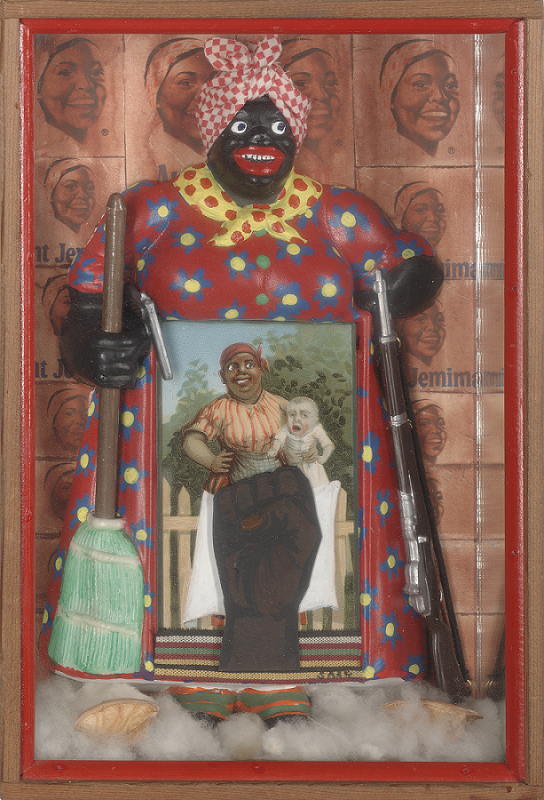The Liberation of Aunt Jemima
Betye Saar, The Liberation of Aunt Jemima, 1972. Collection of Berkeley Art Museum and Pacific Film Archive, Berkeley, California; purchased with the aid of funds from the National Endowment for the Arts (selected by The Committee for the Acquisition of Afro-American Art). Courtesy of the artist and Roberts Projects, Los Angeles, California; Photo Benjamin Blackwell.
Background
By the late 1960s, the U.S. civil rights movement was moving towards a greater emphasis on Black power and pride. In response, artists of all kinds used their talents to convey and explore these concepts through their work.
Women contributed to this outpouring of Black creativity, but they often found themselves on the margins. The Black Power movement was dominated by male voices. And the feminist movement was dominated by white voices. Black women needed to carve out their own space in society and in the art world.
In 1972, the assemblage artist Betye Saar responded to a call for art from the Rainbow Sign. The Rainbow Sign was a Black community center in Oakland, California. Oakland was the birthplace of the Black Panthers and a focal point of the politically-motivated Black Arts Movement (BAM). Since the assassination of Dr. Martin Luther King Jr., Saar’s work had been more political. But her submission to the Rainbow Sign’s exhibition was the first time she intentionally made a political statement through her art. The theme of the exhibition was important figures in Black history. Instead of focusing on a well-known hero, Saar highlighted the heroic resistance of everyday Black women. The piece was called The Liberation of Aunt Jemima.
Saar’s work caused a sensation. The depiction of Aunt Jemima as a liberator and revolutionary resonated with the growing Black Power and feminist movements. Years later, civil rights activist Angela Davis said that The Liberation of Aunt Jemima was the starting point of the black women’s movement.
About the Artifacts
The Liberation of Aunt Jemima is an assemblage made out of everyday objects Saar collected over the years. Its primary subject is the mammy, a stereotypical and derogatory depiction of a Black domestic worker. Saar created this work by using artifacts featuring several mammies: a plastic figurine, a postcard, and advertisements for Aunt Jemima pancakes. The plastic mammy holds two guns. The postcard showing another mammy is tucked behind a Black Power fist. The Aunt Jemima portrait is repeated over and over in the background, staring directly at the viewer. Through The Liberation of Aunt Jemima, Saar transformed these products of Jim Crow racism into a message of empowerment. The mammy is no longer a foolish woman or a victim. She is a gun-carrying self-emancipator.
Vocabulary
- assemblage: A work of art made with a combination of found objects.
- Aunt Jemima: A mammy character used to sell pancake mix and other cooking products.
- Black Arts Movement (BAM): A group of Black artists, poets, musicians, and writers who created politically-inspired materials in the 1960s and 70s.
- Black Power: A civil rights concept that promoted racial pride and solidarity among Black Americans.
- derogatory: Disrespectful and insulting.
- self-emancipator: Someone who frees themselves from a position of oppression.
- mammy: An offensive depiction of a Black nanny, chef, maid, or other domestic worker.
- stereotype: A popular but oversimplified version of a type of person or thing. Stereotypes are often offensive and meant to mock the subject.
Discussion Questions
- What do you see or notice in this work of art? What are the individual elements? How are they arranged?
- Why do you think Saar chose to incorporate offensive objects and images into this work?
- What do you think is the overall message behind this work? What is Saar trying to say about the mammy stereotype? What is she trying to say about Black women?
- Why do you think people reacted so strongly to The Liberation of Aunt Jemima in 1972?
Suggested Activities
- Encourage students to conduct a close analysis of the work of art by identifying each individual element of the assemblage and how it relates to the other elements.
- Compare The Liberation of Aunt Jemima to the print of a Black mother carrying a gun created by Emory Douglas of the Black Panther Party. How does each image promote Black women’s independence? What similarities and differences do students notice?
- Connect Betye Saar to two other Black activist artists in WAMS: Augusta Savage and Elizabeth Catlett. How did each woman use art to participate in the fight for equal rights? What is similar or different about their approaches?
- Angela Davis praised The Liberation of Aunt Jemima for inspiring the Black women’s movement. Analyze this work of art in conjunction with a reading of Angela Davis’s life story. How do these two resources speak to one another? How did Angela Davis’s life mirror Saar’s call for women’s self-emancipation?
- Learn more about mammy stereotypes and deepen students’ understanding of this work by connecting it to the laundry workers resource in WAMS, as well as stereotype resources in the curriculum guide Black Citizenship in the Age of Jim Crow.
- In June 2020, the Quaker Oats company announced that it would retire the Aunt Jemima name and rebrand its line of pancake and cooking products. Invite students to investigate this decision and the discussion around it. How does this information deepen students’ understanding of Saar’s work?
Themes
AMERICAN IDENTITY AND CITIZENSHIP; ACTIVISM AND SOCIAL CHANGE







